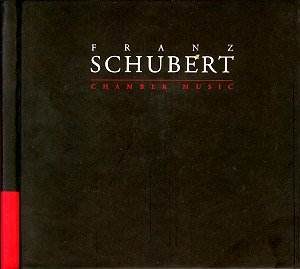|




Andante
|
Franz SCHUBERT (1727-1828)
CHAMBER MUSIC
CD 1
Piano Trio No. 1 in B-flat Major, D.898, Op. posth. 99
Alfred Cortot, piano · Jacques Thibaud, violin · Pablo Casals, cello
Kingsway Hall, London · 5-6 July 1926
Quintet for piano and strings in A Major, "Trout", D.667, Op. 114
Artur Schnabel, piano · Alphonse Onnou, violin, Germain Prevost, viola,
and Robert Maas, cello, of the Pro Arte Quartet · Claude Hobday, bass
EMI Studio No. 1, Abbey Road, London · 16 November 1935
[65:31]
CD 2
Fantaisie for violin and piano in C Major, D.934, Op. posth. 159
Adolf Busch, violin · Rudolf Serkin, piano
Small Queen's Hall, London · 6 May 1931
Piano Trio No. 2 in E-flat Major, D.929, Op. 100
Adolf Busch, violin · Hermann Busch, cello · Rudolf Serkin, piano
EMI Studio No. 3, Abbey Road, London · 23 October 1935
[59:37]
CD 3
Violin Sonata "Grand Duo" in A Major, D.574, Op. posth. 162
Fritz Kreisler, violin · Serge Rachmaninoff, piano
Victor Church Studios, Camden, New Jersey · 20-21 December 1928
Quintet for 2 violins, viola and 2 cellos in C Major, D.956, Op.
posth. 163
Pro Arte Quartet: Alphonse Onnou, violin 1, Laurent Halleux, violin 2,
Germain Prevost, viola, and Marcel Maas, cello 1 · Anthony Pini, cello
2
EMI Studio No. 3, Abbey Road, London · 6-8 March 1935
[64:55]
CD 4
Sonatina No. 3 in G Minor, D.408, Op. posth. 137 No. 3
Jacques Thibaud, violin · Tasso Janopoulo, piano - Studio Pelouze, Paris
· 28 May
1944
Sonatina No. 1 in D Major, D.384, Op. posth. 137 No. 1
Rondo (Allegro vivace only) - Jacques Thibaud, violin · Tasso Janopoulo,
piano - Studio Pelouze, Paris · 28 May 1944
Octet in F Major, D.803, Op. posth. 166
Léner Quartet: Jenö Léner, Joseph Smilovits, Sandor
Roth, Imre Hartman · Claude
Hobday, bass · Charles Draper, clarinet · E.W. Hinchcliff, bassoon · Aubrey
Brain, horn
London · 23 March 1928
[64:10]
 ANDANTE 1991-1994 ANDANTE 1991-1994
|

